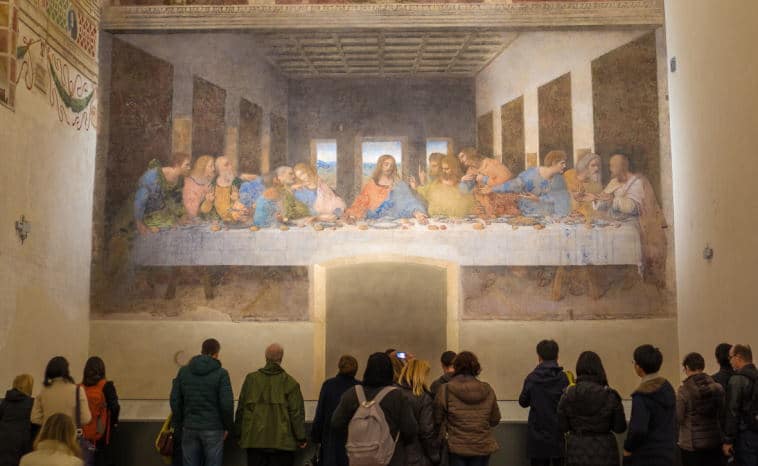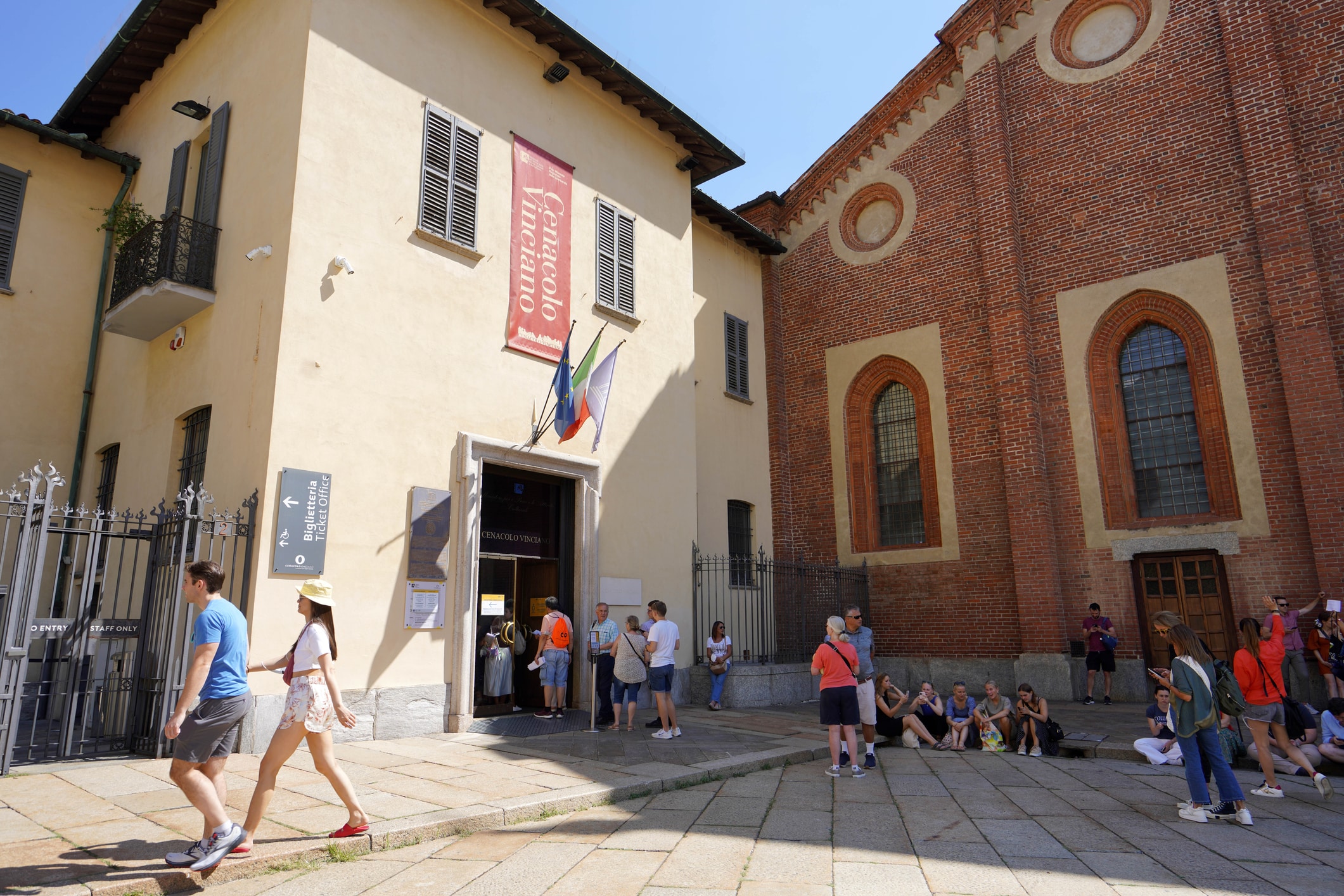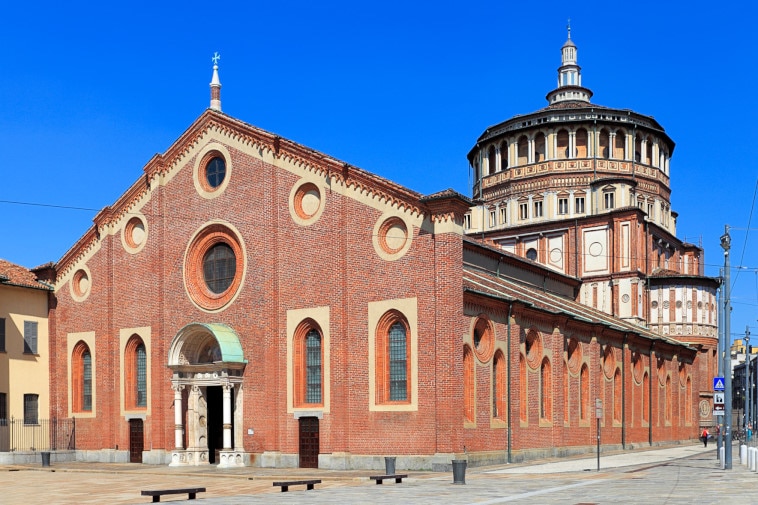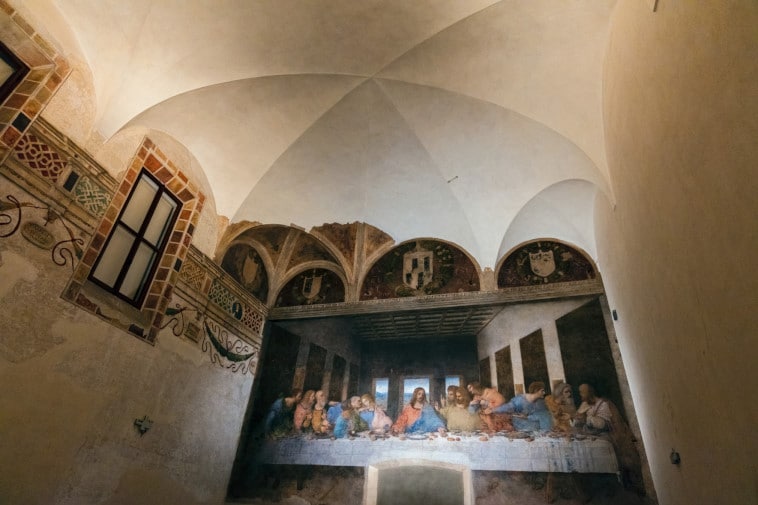Book your Last Supper Experience

Leonardo da Vinci’s The Last Supper is one of Milan’s hardest tickets, so a little planning goes a long way. This guide explains how to make a reservation and—when official Last Supper tickets are sold out—how to choose top‑reviewed Last Supper tours, so the visit can be planned without stress.
Accessibility to visit Leonardo's famous Last Supper is limited. Only 40 people are admitted every 15 minutes. Standard tickets are priced at €15 per person, while a reduced €2 category applies in specific cases, and children under 18 enter free—yet every visitor, including children and infants, must hold a reservation.
As a general rule, the on‑site desk does not sell new tickets and only validates existing bookings. Advance booking through the official website or the call center at +39 02 9280 0360 is required. There is an exception to the rule that tickets are not sold in person (i.e., at the box office): Although it doesn’t happen often, advance reservations are sometimes canceled. In such cases—usually early in the morning—a notice is posted at the ticket office stating that tickets released due to cancellations or returns are available for purchase. That said, this should not be considered a method of purchasing a ticket, and you should not rely on it.
Tickets are released on a rolling three‑month basis and they sell quickly. For instance, dates from 01 November 2025 to 31 January 2026 were opened on Tuesday, 30 September at 12:00. A small extra batch is often added every Wednesday at 12:00 for the week ahead, which may be useful to monitor if a last‑minute spot is needed.
After completing your reservation and before entering, you must present your reservation receipt at the ticket desk next to the entrance (approximately ten meters to the left of the main gate) so that it can be verified by the staff. When collecting your physical ticket at the ticket desk, a valid photo ID (passport or official ID card) is required to verify the names on the reservation; without an official photo ID, you will not be permitted entry. We recommend arriving at least thirty minutes before your slot, as late arrivals may have their reservation canceled.

Entrance to the Cenacolo Vinciano (Last Supper Museum), Piazza Santa Maria delle Grazie 2 — the doorway where ticket-holders and guided tour groups check in. The ticket office is just to the left of the main entrance.
Are you planning to visit the Last Supper Museum with a large group?
Limits apply to ensure fairness: a single online checkout permits up to five tickets (and online purchases are capped at five per buyer per calendar year), while by phone up to nine tickets may be purchased in one call. Groups of ten or more may request dates by email (cenacologruppi@adartem.it) . Please clearly state in your email the full names of all participants, your preferred date and time, the number of visitors, and the type of visit (independent / with an official guide / with an external guide). When booking by email, the museum specifically requires the participants’ names. In addition, for group tour reservations made by email, the maximum group size is 30 people (guide included).
Important Note: Tickets are issued in each visitor’s name and, for individual admissions bought online or by phone, the names cannot be changed. Reservations are final—once booked, no refunds or date changes are permitted.
Evening visits are also available. Evening openings are generally scheduled at irregular intervals in connection with special events such as “European Night of Museums” or “European Heritage Days”,and are announced as “Special Evening Opening”. The museum is closed on Mondays and on 1 January and 25 December.
In addition to the admission options we mentioned above, there is also a free-admission option for The Last Supper. On the first Sunday of every month, admission is free. These free‑entry tickets are released on the official website at 12:00 (Rome time—please note the time zone) on the preceding Wednesday.Free entry does not mean the museum will be overcrowded; the standard capacity rules still apply on free‑entry days (only 40 visitors are admitted every 15 minutes).
For travelers who wish to confirm plans early, or who cannot find official tickets, a Last Supper guided tour can be a good alternative. These guided tours include the Last Supper admission and often combine the visit with Milan’s other top sights.
The key advantage of Last Supper tour is the expert commentary that enriches your time in front of the painting. By joining an itinerary that also covers other iconic Milan landmarks (e.g., the Duomo (Milan Cathedral) and Sforza Castle), you can often bypass long entrance lines and, with your guide’s professional commentary, explore these major sights without missing the details. In 2025, Last Supper guided tours start from €59 per person, and prices may vary by season (high vs. low).
We have long tracked tour operators in Milan and highlight the best value‑for‑money options based on participant satisfaction. For up‑to‑date comparisons of ticket types that include The Last Supper, guided tours, and other Milan tours, you can find all the options together on our page.
Availability update — 12 December 2025: the latest official release is sold out. If you’re visiting soon, try (1) guided tours with Cenacolo entry, (2) the Wednesday 12:00 extra release for the following week, and (3) same‑day cancellations. We’ll refresh this section as things change.
from €15.00 EUR
Closest Date: All tickets are sold out
Duration: 15 Minutes
Organized by: Cenacolo Vinciano Vivaticket
from €76.00 EUR
Duration: 3 Hours
Organized by: Wander Italy
5.897 Reviews
from €59.00 EUR
Organized by: Ways Tours
1.186 Reviews
from €79.00 EUR
Duration: 1 hour
Seller: Tiqets
137 Reviews
from €80.00 EUR
Duration: 3 Hours
441 Reviews
from €99.00 EUR
Duration: 3.5 Hours
Organized by: Zani Viaggi Srl
2.182 Reviews
from €94.00 EUR
Duration: 6 Hours
Organized by: Veditalia
699 Reviews
from €99.00 EUR
Duration: 3.5 Hours
Seller: Tiqets
318 Reviews
from €169.00 EUR
Closest Date: December 9
Duration: 3 Hours
Organized by: LivItaly Tours LLC
33 Reviews
from €134.00 EUR
Duration: 6 Hours
Organized by: Wander Italy
303 Reviews
from €470.00 EUR
Duration: 3 hours
Organized by: Memento | Italy In Style
127 Reviews
from €109.00 EUR
Duration: 45 min.
Organized by: LivItaly Tours LLC
520 Reviews
from €134.00 EUR
Duration: 6 Hours
Organized by: Tiqets
55 Reviews
About Leonardo da Vinci's Last Supper
Santa Maria delle Grazie is one of the most beautiful churches in Italy. It was built in the 15th century, initially in the late Gothic style, and was rebuilt in the Renaissance style from 1492 by Bramante (1444 -1514). The highlight of the church is the fresco "The Last Supper" by Leonardo da Vinci (1452 -1519). It is considered one of the greatest masterpieces in the history of art and captures the moment when Jesus speaks the words: "One of you will betray me". The entrance to what used to be the refectory of the Dominican convent is in the square in front of Santa Maria delle Grazie. It is in this refectory that, between 1495 and 1497, Leonardo da Vinci painted the Last Supper.

The painting occupies all of the wall at the end of the refectory; in the three lunettes over the fresco, below the decorations of the vault (which was destroyed in 1943) are the coats of arms of the Sforza and the Este families surrounded by wreaths, a tribute to Duke Ludovico il Moro and his wife, Beatrice d'Este. Some scholars maintain that the scene by Leonardo of the twelve Apostles seated together with their Lord at the supper table portrays them at the moment when Jesus announced that one of them would betray him, or, as others say, at the moment of the Consecration.
The reaction of the Disciples is apparent from their exaggerated gestures, emotional movements, and facial expressions, and contrasts with the immobility of Christ who dominates the scene from the center of a rigorously symmetrical composition in perfect perspective. The whole scene seems to be bathed in a diffused, gentle light coming partly from the three windows at the far end of the room and partly from the light at the front from the actual window in the real room. The figures are one third bigger than life-size and show masterly particulars of execution: after having done the sketches by pen and outlining the figures in their various poses, Leonardo drew naked figures which he later dressed with color. The painting is done in tempera- forte with a technique that allowed an exquisite fineness in the passage of tones due to the perfect mixing of colors. On the opposite wall, in front of the “Last Supper”, is the great “Crucifixion” painted in fresco by Donato Montorfano in 1495.

The painting was miraculously left undamaged by the bombings of August 1943 which partially destroyed the nearby cloisters and parts of the church. The great painting has always been in a precarious state of conservation, and even Leonardo himself, when he had finished the work, declared that the work suffered from the humidity of the ground on which the building stood. Since 1517 it has steadily deteriorated, mainly because of the new painting technique used by Leonardo as an experiment. When a door was opened up in the wall, one of Christ’s legs was cut, while the restorations carried out in 1726 and 1770 only helped to increase the instability of the colors. At the time of Napoleon, the refectory was used as a stable and in 1801 was flooded by water. In 1953 the fresco was cleaned and consolidated; a complex and radical restoration procedure was completed in the second half of the 1990's so that this marvelous work can now be seen by the public again.
Milan Museum Tickets
Explore the vibrant art and culture scene in Milan with our comprehensive guide to the city's most popular museums. Find the perfect ticket or tour tailored to your interests, as we showcase options with the highest ratings and greatest number of reviews. Our selection includes world-renowned attractions such as the iconic Last Supper, La Scala Opera House, and the Sforza Castle. Don't miss out on these top-rated experiences – make your visit to Milan truly unforgettable with our expertly curated museum tickets and tours.
from €26.00 EUR
Validity: 3 Days
Organized by: Veneranda Fabbrica Duomo di Milano
58.769 Reviews
from €16.00 EUR
Seller: Tiqets
536 Reviews
from €14.00 EUR
Closest Date: All tickets are sold out
Seller: Tiqets
128 Reviews
from €18.50 EUR
Seller: Tiqets
365 Reviews
from €31.00 EUR
Duration: 1 Hour
Organized by: Z V SRL
2.857 Reviews
Guided Milan Tours
Explore the best of Milan with our handpicked selection of popular tours, carefully curated based on user ratings and reviews. These top-rated experiences offer an in-depth look at the city's rich history, culture, and stunning architecture, ensuring a memorable trip for every traveler. Our list showcases tours that have garnered high praise from participants, with a proven track record of both excellent ratings and numerous reviews. Immerse yourself in the beauty and charm of Milan as you embark on these highly recommended guided tours, and let the city's allure captivate you.
from €145.00 EUR
Duration: 2.5 Hours
Organized by: Your Travel Diary
17 Reviews
from €25.00 EUR
Duration: 1 Day-48 Hours
Organized by: Sightseeing Experience
5.924 Reviews
from €25.00 EUR
Organized by: Zani Viaggi
187 Reviews
from €65.00 EUR
Duration: 2-3 Hours
Organized by: Fat Tire Tours – Italy
430 Reviews
from €79.00 EUR
Duration: 3 Hours
Organized by: Florencetown
817 Reviews
from €140.00 EUR
Duration: 2 hours
Organized by: Keys Of Italy / Milan and Venice
19 Reviews
from €39.50 EUR
Duration: 1 day
Seller: Tiqets
583 Reviews
from €50.00 EUR
Duration: 2 hours
Organized by: Wander Italy
1.214 Reviews
from €52.90 EUR
Duration: 8 hours
Organized by: Italy Hidden Experiences
22 Reviews
Day Trips from Milan
Explore the best day trips from Milan and make the most of your Italian adventure. Our carefully curated selection showcases the highest-rated and most popular excursions, ensuring you experience top-notch destinations. Popularity is determined by a combination of excellent user ratings and a high number of reviews, guaranteeing you a memorable journey. Whether you're seeking historic landmarks, stunning landscapes, or culinary delights, these day trips promise to surpass your expectations and create lasting memories. Uncover the gems surrounding Milan and enrich your travel experience.
from €99.00 EUR
Duration: 10 Hours
Organized by: Autostradale Viaggi
10.410 Reviews
from €119.00 EUR
Duration: 12.5 Hours
Organized by: Zani Viaggi Srl
1.668 Reviews
from €99.00 EUR
Duration: 12 Hours
Organized by: Z V SRL
252 Reviews
from €129.00 EUR
Duration: 14 hours
Organized by: Z V SRL
743 Reviews
from €149.00 EUR
Duration: 13 hours
Organized by: Z V SRL
155 Reviews
from €129.00 EUR
Duration: 12 Hours
Organized by: Z V SRL
410 Reviews
from €139.00 EUR
Duration: 13 hours
Organized by: Z V SRL
767 Reviews
from €690.00 EUR
Duration: 10 hours
Organized by: Memento Italy
6 Reviews
from €79.00 EUR
Duration: 9 hours
Organized by: Z V SRL
3 Reviews
from €139.00 EUR
Duration: 1 Day
Organized by: Z V SRL
25 Reviews
Transport Tickets
from €10.00 EUR
Seller: Tiqets
90 Reviews
from €5.00 EUR
Seller: Tiqets
94 Reviews
from €10.00 EUR
Seller: Tiqets
208 Reviews
